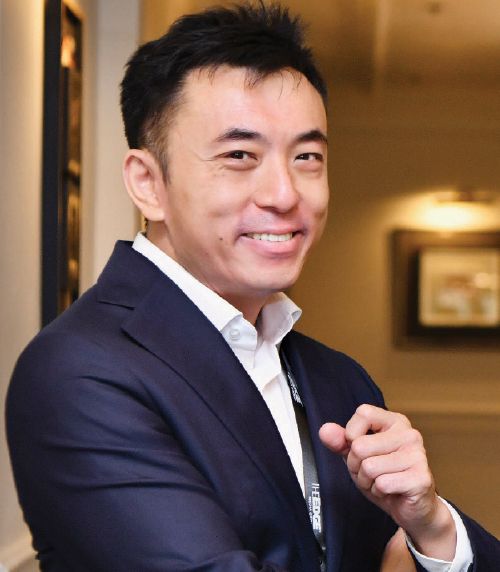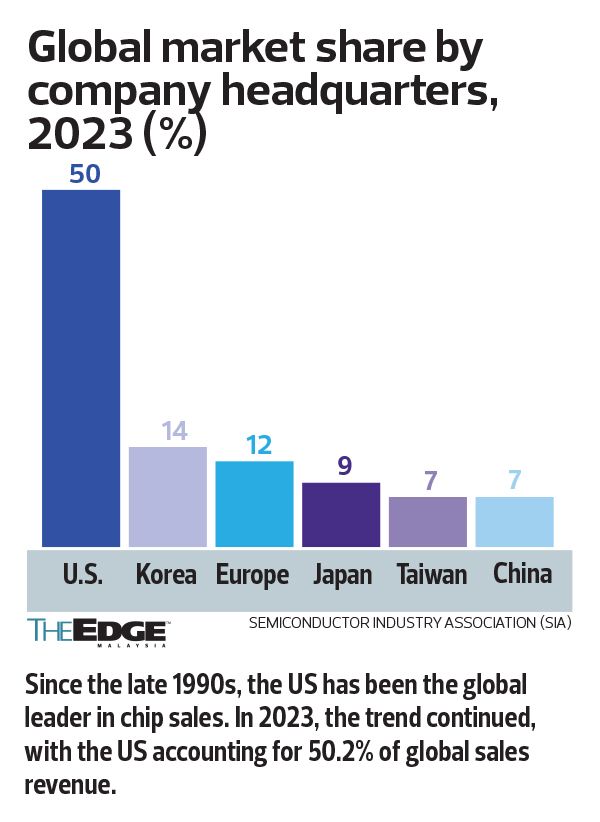
MNCs in the global semiconductor sector see Malaysia under the current government as an attractive place to operate and make major new commitments. (Photo by Shahrin Yahya/The Edge)
This article first appeared in The Edge Malaysia Weekly on February 17, 2025 - February 23, 2025
US president Donald Trump’s return to the White House has further disrupted global trade, particularly in semiconductor and technology supply chains, which has prompted the European Union (EU) and Japan to intensify efforts to bring key industries back home to safeguard their economies.
But these economies face growing competition from China, an economic powerhouse rapidly expanding its footprint in renewable energy and advanced manufacturing, although Beijing faces escalating US technology restrictions as Washington pressures other nations to align with its policies.
At the same time, rapid advancement of artificial intelligence (AI) and deep learning has intensified the global tech war, with companies and governments racing to lead the AI and semiconductor space.
Nvidia Corp remains the dominant force in AI chips, particularly in graphics processing units (GPUs), which have become the industry standard for training large AI models.
OpenAI’s ChatGPT has also set the benchmark for large language models, popularising generative AI and serving as a key reference point for AI chatbot performance.
But China is quickly making its mark.
The rise of AI start-ups such as Hangzhou DeepSeek Artificial Intelligence Basic Technology Research Co Ltd has shaken up the landscape following its recent launch of a powerful AI model that reportedly operates on less advanced chips, signalling a potential shift in AI development strategies.
Shortly after, Alibaba Group Holding Ltd claimed its latest AI model outperforms DeepSeek’s, reinforcing the idea that the AI race isn’t just about having the most advanced chips but about developing smarter algorithms.
Additionally, yet another Chinese company, Tencent Holdings Ltd, reportedly introduced an updated 3D-generation system based on its AI foundation model, Hunyuan, on open-source platforms. The move is expected to significantly enhance video game development, reducing the time required to create three-dimensional content from days to just minutes.
For Malaysia, which aspires to venture into the AI space, the challenge is compounded by limited alternatives for advanced semiconductor imports, even though the country remains deeply integrated into the global chip supply chain, particularly in assembly, testing and packaging.
Given these constraints, John Lee — an expert on foreign relations, political economy and high-tech industries — believes Malaysia will need to comply with US technology restrictions to sustain its AI ambitions.
Access to US technology, whether through direct imports or collaboration with multinational firms, will be essential for Malaysia’s AI progress. As Washington tightens controls and Beijing pushes for self-sufficiency, Malaysia must navigate these geopolitical tensions carefully to maintain its role in the AI and semiconductor landscape.
“For Malaysia [indeed for all countries], the dilemma is that there are very limited import substitution options. Even if China’s domestic industry closes the gap rapidly over the next few years with the global industry in leading-edge fabrication capacity, China is unlikely to have much spare capacity for export.
“Chinese domestic data centre capacity is also likely to be prioritised for Chinese firms and there will be no lack of domestic demand in China for such services. So, for years to come, compliance with US controls will be necessary for Malaysia to proceed with its own AI goals,” Lee says in an interview with The Edge.
Lee is the director of East-West Futures, a consultancy specialising in China’s high-tech industries, political economy, military capabilities and international diplomacy.
He is also a researcher at the Leiden Asia Centre and a visiting fellow at the ISEAS–Yusof Ishak Institute, National University of Singapore.
His research focuses on China’s role in the semiconductor and automotive industries, telecommunications and the Internet of Things, and governance of cyberspace and the internet.
The US’ Asean reservations
On Jan 13, the Joe Biden administration released the “Export Control Framework for Artificial Intelligence Diffusion”, a new export control rule that places Malaysia in Tier 2, restricting access to advanced AI chips such as GPUs to a maximum of 50,000 units over two years.
Lee says that the US chip curbs should be seen in a larger context.
Apart from the AI diffusion rule, he points out that other other recently published rules concerning chip-making equipment and high-bandwidth memory as well as due diligence requirements for foundries and outsourced semiconductor assembly and test also create, in effect, a tiered system for countries worldwide.
This reflects the level of trust the US government has in the given country’s policy stance towards China and in its capacity to enforce controls targeting China, whether these are US controls or its own domestic laws.
“Across all these rules, all the Asean countries are in the ‘less trusted’ tier, [which is] only above the ‘zero access’ tier of the US arms-embargoed countries including China. As such, they are subject to the maximum licensing requirements and most restrictive caps on access to computing power provided by US companies,” Lee says.
“Another key aspect of these rules is that they are clearly meant to pressure third countries to harmonise their own rules with the US controls targeting China. For the Asean countries, this is the only way to reach the most privileged tier of licensing exemptions.
“However, even the ‘inner circle’ of most trusted US allies could easily lose this status, simply by being removed from one list supplement to the US export administrative regulations. So, even in their case, there is an implied threat that if they do not harmonise their own controls with the US ones, the US controls will be imposed on their companies in the same way as for firms in the Asean states,” he says.
Lee adds that the licensing structure for these rules is that they clearly target outsourcing by the American, European and Japanese firms to Southeast Asia, since subsidiaries in Asean of firms headquartered in “Tier 1” countries do not enjoy the same licensing exemptions vis-à-vis China as their parent firms in the more trusted home countries.
“Overall, the US government’s intent is clearly to clamp down on Southeast Asia as a ‘loophole’ in the US tech containment campaign against China, at the cost of the local economies’ development if necessary.
“The Biden administration in its last days wanted to show that they meant business on this issue to Asean countries and the world at large, [considering] many European countries are in ‘Tier 2’ for the AI diffusion rule,” he observes.
Now, if the Trump administration maintains this approach, Lee is of the view that there will probably be some hard choices forced on Malaysia and other Asean states but not enough to justify a complete realignment of policy towards China, which would be a bad idea on many levels.
To be clear, Trump had revoked a 2023 executive order by Biden on his first day back in the White House — an order aimed at mitigating AI-related risks to consumers, workers and national security — but the AI diffusion rule remains under a 120-day comment period.
In other words, the new rule will only take effect as early as May 15, giving the Trump administration time to intervene. But the question remains whether Trump will reverse or modify Biden’s AI chip export restrictions.
“It’s difficult to say which way Trump will go with this, except to note that he’s said he doesn’t like sanctions [as opposed to tariffs] as a tool because he thinks that they drive third parties to move away from using the US dollar and using US technology in the context of the semiconductor supply chain.
“There is, in fact, a lot of evidence to support this view. It is also worth noting that one of the fastest ways to reduce the US trade deficit with China, which is another goal Trump personally talks about, would be to let China import a wider range of chips and related products like chip-making equipment by removing US export controls on them,” Lee says.
When asked about the impact of DeepSeek, he says that it is still too early to speak of the effects.
“The main points I’d make are that there’s no sign yet of the US tech majors cutting back investment in data centres or leading-edge GPUs. This will certainly help the Chinese industry remain competitive globally despite the US export controls, especially where AI can synergise with areas of the Chinese manufacturing sector’s strength.”
Malaysia still an attractive place
Closer to home, Malaysia’s National Semiconductor Strategy — a three-phase, 10-year road map unveiled in May 2024 — aims to attract RM500 billion in investments, with an emphasis on integrated circuit design and advanced packaging. To support this, the government has allocated RM25 billion in targeted incentives and fiscal measures.
Lee observes that based on the new projects announced over the past four years, it is clear that the multinational corporations (MNCs) in the global semiconductor sector see Malaysia under the current government as an attractive place to operate and make major new commitments.
Nevertheless, Lee admits it is unlikely Malaysia is going to be competitive in attracting much front-end fabrication as most of the major regional investments by MNCs in this segment are still going to Singapore.
“Attracting more chip design work in tandem with the local development of other industry verticals, notably the automotive sector, where the prospects are relatively good though this depends on the availability of talent,” he says.
Save by subscribing to us for your print and/or digital copy.
P/S: The Edge is also available on Apple's App Store and Android's Google Play.
- Gas pipeline blaze: MIDF flags potential RM18m impact to Petronas Gas
- Gas pipeline blaze: Petronas Gas, Gas Malaysia’s shares open marginally lower after trading halt
- T7 Global drops to two-year low, triggers short-selling halt after deputy chairman's departure
- Digital banks in Malaysia urged to re-examine strategies to better serve B40 segment
- Yinson's shares slip, analysts tell investors to look past underwhelming results
- CIMB, Bank Islam, Etiqa to assist Putra Heights fire incident victims
- China curtails more renewables as record additions stress grid
- US tariffs expected to affect Asia Pacific economic growth – S&P Global
- SC Annual Report 2024: SC swings to RM20.7 mil operating surplus, recovering from largest deficit in a decade in 2023
- SC Annual Report 2024: Malaysia’s capital market outperforms regional peers, funds raised hit RM138.9 bil in 2024


